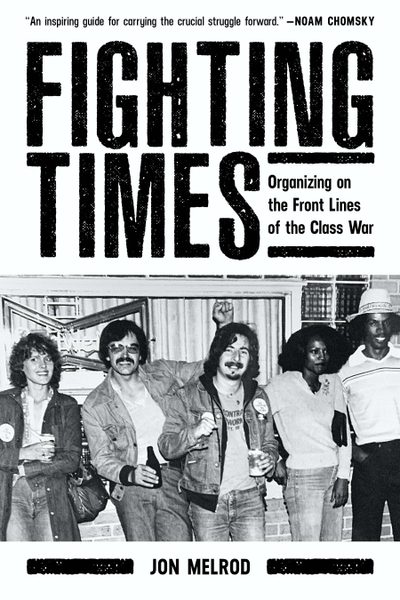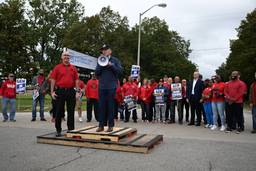Lessons From a Radical Past: One Man’s Journey Into the Factories in the 1970s
A veteran of the New Left’s turn to the factories tells his story.
Peter Olney

A national direct election will be held in the fall for the United Auto Workers (UAW), which held its 38th constitutional convention the week of July 25 in Detroit. Once an industrial union power with almost 1.5 million members in 1979, the union has been reduced to roughly 400,000 active members (though it has nearly 600,000 retirees) — and about a quarter of its members are graduate teaching assistants and other university workers in higher education.
The union, for decades, has been governed by the Administration Caucus, which perpetuated its rule by tightly managing the conventions to elect union officers (though the leadership of UAW has been resistant to charges that it is undemocratic). But after the federal government brought suit against the union’s leaders for rampant corruption, the settlement reached in 2020 forced the union to give members a vote on whether to directly elect officers. The movement for “one member, one vote” won a membership referendum in 2021, and the constitutional convention in July saw a number of nominated challengers to the incumbent president.
But “one member, one vote” is not a new concept in the history of the UAW. At the 1983 UAW convention, Jon Melrod and his fellow UAW delegates from Local 72, representing the American Motors Corporation plant in Kenosha, Wis., came to Detroit allied with other reformers to push for a national direct vote. At that convention, according to Melrod’s telling, the Administration Caucus’s control of the gavel kept the issue from the convention floor, but Melrod’s legacy still lives on almost 40 years later — grounded in the daily battles Melrod and his comrades fought for democracy on the assembly lines of the auto industry.
As their practice illustrates, union reform is only a tangible and living demand when it is coupled with the needs and interests of the rank and file — especially as they come into conflict with both the company and a do-nothing union bureaucracy.

Fighting Times: Organizing on the Front Lines of the Class War by Jon Melrod (PM Press, September 2022)
Melrod’s Fighting Times: Organizing on the Front Lines of the Class War (PM Press, September) tells the story of Melrod’s 13 years working at American Motors as a socialist agitator and a builder of working-class power. The book is an autobiographical response to a question once posed by his sons: “Dad, after having your intestines cut up and battling pancreatic cancer caused by factory chemicals, would you have made the same choice to work in those factories you’ve told us about?” Melrod answers in the affirmative and focuses on his work from the early 1970s to the mid 1980s at the American Motors Corporation manufacturing facility in Kenosha, an industrial manufacturing town on Lake Michigan halfway between Chicago and Milwaukee.
Graduating from the University of Wisconsin-Madison and migrating to Milwaukee to enter the working class, Melrod, in 1972, gets hired by American Motors and works there until his discharge for union activity in 1973. While fighting his illegal discharge at the federal National Labor Relations Board (NLRB), Melrod takes other employment in a rotten, smelly tannery and then in a steel fabrication shop, where he leads a successful strike. After Melrod wins his NLRB case and is rehired by American Motors, he soon — along with his whole department — is transferred to the Kenosha facility, where he works until 1985. (After, he leaves for law school in California.)
The book is a most relevant tale as today’s younger socialist generation takes up the cause of the revitalization of the labor movement and the challenge of organizing millions of new workers. Melrod is not unique in the “career path” he chose in the 1970s; inspired by the civil rights and anti-Vietnam War moment, Melrod and many others saw the working class as the motive force for sweeping change in the United States.
Melrod’s opening chapters follow his on-campus activity in Madison and his work as a supporter of the Black Panthers. He, like so many others in what was called the New Communist Movement, chose to express their politics by joining the working class. Melrod’s center of gravity for that organizing was the fight over day-to-day, bread-and-butter and human dignity issues. While Melrod and his comrades did not shirk from speaking to issues of race and police brutality, or from joining in struggles outside of the plant, they believed day-to-day battles were the best way to win workers to a broader social vision.
That vision was expressed as, “I’ve always been straight about my belief that capitalism is an unfair, stacked system built on the backs of workers; on the immediate agenda, however, is winning a good contract” — a fair statement, given much of the New Communist Movement was paying homage to Mao’s China, a model that would not have resonated in Kenosha and Milwaukee. It is interesting to note, however, that Milwaukee was home to Victor Berger and the “sewer socialists” of the early 20th century. Berger, a member of the Socialist Party, was elected to multiple terms in Congress representing Milwaukee’s 5th District starting in 1910. (Berger and his comrades are a probably better fit for today’s Berniecrats than the Communist Party of China.)
Melrod faced constant attacks from American Motors because of his politics, and many workers were uncomfortable with Melrod’s red affiliations, but herein lies potential lessons for today’s organizers who must deal with MAGA working-class sentiments. In one case, Melrod describes a tense discussion with a National Socialist White People’s Party member named Deadeye DiMarino, who threatens the “Commie” Melrod with a .38 revolver stuck at the local bar. Melrod reacts by ordering more shots and beers and peppering Deadeye with talk of their common struggle over issues in the plant.
“A number of shots later, a shit-faced Deadeye was telling me he loved me as a union brother,” Melrod writes. “Finally, we swiveled off our stools and wobbled out the back door.”
While Melrod’s career options, as a college grad from a prestigious university in the 1970s, were much more open than his fellow workers on the assembly line, he threw himself into the everyday social intercourse of factory life. He was willing to throw down with any management stooge who tried to bully him and any union leaders who tried to sideline him. “Belly bumping” in physical confrontations with managers became part of Melrod’s weekly routine. But he was careful not to allow himself to be isolated, always seeking out allies and building the broadest front around shop-floor issues.
Being a union militant was a 24/7 job. The publication of the shop-floor newsletter, Fighting Times, required Melrod to crank it out in his basement. He was meeting day and night with fellow comrade organizers and workers who were part of his caucus. The intensity of his work as a socialist organizer and agitator is admirable.
Melrod did have the protection of a very strong union contract with a living wage and a powerful steward system at American Motors. Today’s organizers often confront the rigors of working in low-wage, nonunion facilities without a living wage and no redress from the physical stresses of their working environment. With union density in the private sector around 6% and Amazon threatening the existence of unionized sectors in the U.S. Postal Service and United Parcel Service, organizing the unorganized at Amazon is one of the key tasks on socialist labor’s agenda. The turnover and churn at Amazon among hourly workers is over 100% annually — which likely means unionizing Amazon will require the commitment of young comrades willing to enter the workforce the way Melrod did in the 1970s.
But for these young organizers, what is the balance between commitment and personal sustainability?
Fighting Times, the book, offers a rich account of shop-floor struggle and the interplay of that work with attempting to build a more politically conscious working-class movement. Melrod’s experience, of course, is limited by the historical moment of the 1970s and early 1980s, pre-dating the explosion of socialist electoral activity triggered by Bernie Sanders’ 2016 and 2020 presidential runs. But Melrod’s discussion of deep shop-floor organizing is a must-read for young comrades. He certainly embodies the type of Industrial Workers of the World organizer that Italian Marxist Sergio Bologna described as “an absolutely original type of agitator…who swims within the stream of proletarian struggles…rides the seismic wave of the struggle, overcoming national boundaries and sailing the oceans…”
Ride on, Jon. And right on — to the socialist youth of today who take up the challenge of working-class organizing.
Peter Olney is retired Organizing Director of the International Longshore & Warehouse Union. He has been a labor organizer for 50 years working for multiple unions before landing at the ILWU in 1997. For three years he was the Associate Director of the Institute for Labor and Employment at the University of California.






